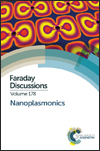Control of Förster energy transfer in the vicinity of metallic surfaces and hyperbolic metamaterials
Abstract
Optical cavities, plasmonic structures, photonic band crystals and interfaces, as well as, generally speaking, any photonic media with homogeneous or spatially inhomogeneous dielectric permittivity (including metamaterials) have local densities of photonic states, which are different from that in vacuum. These modified density of states environments are known to control both the rate and the angular distribution of spontaneous emission. In the present study, we question whether the proximity to metallic and metamaterial surfaces can affect other physical phenomena of fundamental and practical importance. We show that the same substrates and the same nonlocal dielectric environments that boost spontaneous emission, also inhibit Förster energy transfer between donor and acceptor molecules doped into a thin polymeric film. This finding correlates with the fact that in dielectric media, the rate of spontaneous emission is proportional to the index of refraction n, while the rate of the donor–acceptor energy transfer (in solid solutions with a random distribution of acceptors) is proportional to n−1.5. This heuristic correspondence suggests that other classical and quantum phenomena, which in regular dielectric media depend on n, can also be controlled with custom-tailored metamaterials, plasmonic structures, and cavities.
- This article is part of the themed collection: Nanoplasmonics

 Please wait while we load your content...
Please wait while we load your content...